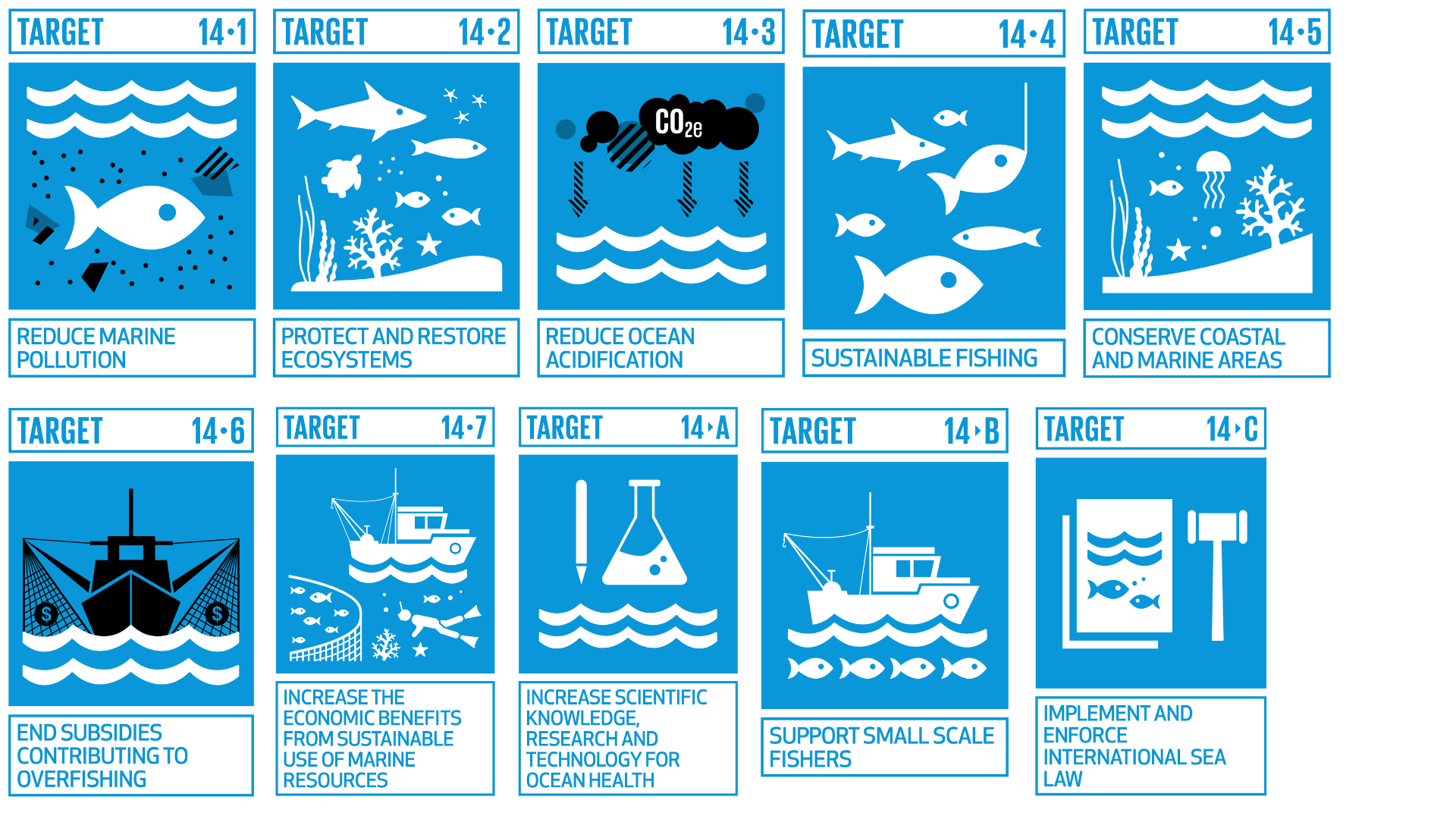SDG 14 - Conserve and sustainably use the oceans, seas and marine resources for sustainable development
Actions for SDG 14
Collaborate to prevent water contamination ⬇
- Have a responsibility policy that includes the protection of seas and oceans
- Have indicators to calculate the impact of your activity on seas and oceans
- Work with cleaning companies that do not use polluting chemicals
- Develop sustainable practice manuals for employees
- Collaborate with an NGO that aim to preserve life below water
- Utilize a value-chain approach to create connections between the design, packaging, marketing and recycling of materials with the goals of reducing their environmental impact at the end of their lifecycle
Ensure sustainable use of aquaculture and marine resources ⬇
- Collaborate with companies that offer water activities and services in a sustainable manner
- Provide items that help reduce pollution (portable ashtrays, reusable bottles, etc.) to your customers
- Make sure that the beaches have selective waste collection buckets
- Collaborate with partners to carry out assessments of the ecological status of ocean systems
- Remove all single-use plastic from your commercial operation
- Prohibit practices that put marine species and resources at further risk of harm, exploitation or depletion
- Contribute to the development of waste management technologies that minimize the use of clean water
Encourage awareness and respect for aquatic ecosystems ⬇
- Carry out environmental education workshops about the aquatic/marine ecosystems of the territory
- Inform about the negative effects of pollution on aquatic ecosystems
- Place information panels with sustainable practices and data of interest nearby aquatic/marine ecosystems
- Create synergies with local aquariums that help protect the marine environment and endangered species
- Raise consumer awareness on effective ways to properly dispose of their waste to discourage littering and promote responsible behavior
Develop and offer sustainable activities that promote the respectful use of beaches and marine environments ⬇
- Organize beach cleanups against waste and plastic pollution
- Collaborate with companies that offer water activities and services in a sustainable manner
- Report on legislations, criteria and means to avoid over-fishing
- Support sustainable beach management measures by the public administration
- Organize cinematic screenings for documentary films on the sustainable use and pollution of marine ecosystems
- Track the life cycle of products and materials in order to understand how they are disposed and which products could likely find their way into marine environments
- Record and disclose information on the chemical and material usage within products, packaging, and processing systems to facilitate closing the loop
- Improve resource efficiency by altering the design, manufacture, or use of products and packaging to reduce the amount of waste that could potentially enter the environment
- Improve resource efficiency by generating value from waste.
- Replace, limit or prohibit the use of certain chemicals, additives, or materials that could prevent closing the loop or lead to nutrient pollution or chemical and physical hazards if they happen to reach marine ecosystems
- Prevent waste mismanagement or littering that could pollute the marine environment
SDG 14 in Canada
Conserve and sustainably use the oceans and marine resources for sustainable development. ⬇
Healthy and resilient oceans help to mitigate the effects of climate change, provide food security to millions of people around the world and drive economic activity through marine trade and transport.
In November 2016, Canada launched the $1.5-billion Oceans Protection Plan, the largest investment ever made to protect Canada’s coasts and waterways.
- The Plan aims to enhance our marine safety system, further protect marine ecosystems and habitats, create stronger Indigenous partnerships and engage coastal communities, provinces, territories, industry and other stakeholders and invest in oil spill clean-up research.
Through the Oceans Protection Plan, Canada works with partners and engages Indigenous and coastal communities to make navigation safer by supporting enhanced sharing of marine traffic information with local communities in real-time, providing modern hydrography and charting in key areas of high-traffic waterways, and setting tougher requirements on industry to provide quicker action for any spill from a ship.
Canada has also taken steps to help address the health of our oceans and aquatic systems through new regulations, under the Canadian Environmental Protection Act, that prohibit the manufacture, import and sale of toiletries containing plastic microbeads; the regulations came into force in January 2018. Micro-plastics have been observed in industrialized coastal waters, in the open ocean and in remote environments such as the Arctic.
Canada is taking a leadership role on advancing action on ocean plastics, most notably through its G7 presidency and the adoption of the Ocean Plastics Charter by five of the G7 countries, which includes ambitious targets to move toward a more resource efficient and sustainable approach to the management of plastics to prevent their leakage into the marine environment.
Canada has now surpassed its own domestic marine conservation target—to protect 5% of its marine and coastal areas by the end of 2017—largely by establishing marine protected areas (MPAs) and identifying other effective areabased conservation measures across Canada’s marine bioregions. Canada is also exploring ways to protect the “Last Ice Area” in the Arctic, in collaboration with Indigenous and northern partners.
Snapshot of available data ⬇
- Canada has protected 7.75% of its marine and coastal areas (as of December 2017) by establishing federal, provincial and territorial MPAs and other effective area-based conservation measures.
- Canada continues to track the performance of the major fish stocks it manages through the Sustainability Survey for Fisheries. The 2016 survey examined 170 stocks and noted whether they are managed and harvested at levels considered to be sustainable. It also assessed the use of the precautionary approach in managing these fish stocks. The survey data is also used in the Canadian Environmental Sustainability Indicators report, which tracks Canada’s performance on key environmental sustainability issues
Nature Conservancy of Canada ⬇
- The Nature Conservancy of Canada (NCC) is working to protect biodiversity within marine ecosystems across the country.
- NCC’s largest Atlantic Canada conservation area is the Musquash Estuary in New Brunswick, with more than 2,000 hectares of marshes, coastal forests and cobble beaches surrounding this important ecosystem. In Nunavut, NCC is helping establish Canada’s largest marine protected area to protect a biodiversityrich area of key importance both ecologically and to the Inuit population of the region.
Latest Updates/Resources related to SDG 6
Sources
Government of Canada, Canada’s Implementation of the 2030 Agenda for Sustainable Development - Voluntary National Review, 2018
SDG Compass, Learn More About the SDGs, 2015






